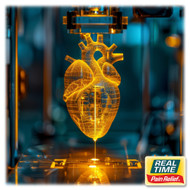3D Printing and Bioprinting: Revolutionizing Patient Care through Personalized Medicine
Posted by Dennis R. Escalera on 1st Apr 2024
The realms of 3D printing and bioprinting are heralding a new era in healthcare, offering unprecedented precision and personalization in treatment modalities. From the fabrication of multi-drug pills to the development of synthetic organs, these technologies are setting the stage for a healthcare revolution, tailored to meet individual patient needs while overcoming the limitations of traditional treatment methodologies.
3D Printing in Medicine: Beyond Conventional Boundaries
3D printing, a technology once relegated to the domains of manufacturing and design, has found a novel application in the pharmaceutical sector. The capability to 'print' pills encapsulating multiple medications is a significant stride towards simplifying medication regimens. This innovation not only aids in the management of complex medication schedules but also ensures the precise dosage of drugs, thereby enhancing treatment efficacy and patient compliance.
Moreover, 3D printing transcends the pharmaceutical realm, venturing into the creation of prosthetics and implants with customization at its core. This personalization is crucial, as it ensures a higher compatibility and comfort level for patients, thereby improving clinical outcomes.
The Advent of Bioprinting: A Leap into the Future
Bioprinting, an offshoot of 3D printing, focuses on creating living tissues and organs, marking a pivotal shift in regenerative medicine. Initially celebrated for its ability to regenerate skin for burn victims, bioprinting's ambit has now expanded to include the fabrication of blood vessels, synthetic ovaries, and pancreases. These bioprinted organs are not mere placeholders; they have the potential to grow within the recipient's body, effectively replacing their defective counterparts.
The most groundbreaking aspect of bioprinted organs lies in their compatibility. Traditional transplant methodologies often grapple with the body's immune response, leading to rejection. However, bioprinted organs, tailored to the patient's biological makeup, significantly reduce the likelihood of rejection, thus heralding a new frontier in organ transplantation.
Challenges and Ethical Considerations
Despite its promising outlook, the integration of 3D printing and bioprinting in healthcare is not without its hurdles. The ethical implications of creating synthetic life forms, the potential for inequality in access to these advanced treatments, and the technical challenges related to the scalability and affordability of such technologies are subjects of ongoing debate and research.
Furthermore, regulatory frameworks have yet to catch up with these rapid advancements, necessitating a concerted effort from policymakers, scientists, and ethicists to ensure these technologies benefit society at large without compromising ethical standards or exacerbating existing healthcare disparities.
Looking Ahead
The trajectory of 3D printing and bioprinting in healthcare is undoubtedly upward, driven by the relentless pursuit of more effective, personalized, and accessible treatment options. As research progresses and these technologies mature, their integration into mainstream healthcare could dramatically transform patient care, making previously inconceivable treatments a reality.
Conclusion
This article synthesizes the current state and potential of 3D printing and bioprinting technologies in revolutionizing healthcare. By creating more personalized and precise treatments, these innovations promise to enhance patient care significantly. However, as we navigate this promising future, it's imperative to address the challenges and ethical considerations these technologies bring to ensure they lead to equitable and beneficial outcomes for all patients.
References
- "Top 10 new medical technologies of 2022", Proclinical Blogs. Available at: www.proclinical.com/insights/2022-02-10/top-10-new-medical-technologies-of-2022
- "3D Printing and Bio-Printing in Healthcare", World Economic Forum. Available at: www.weforum.org/agenda/2023/02/health-future-innovation-technology/





